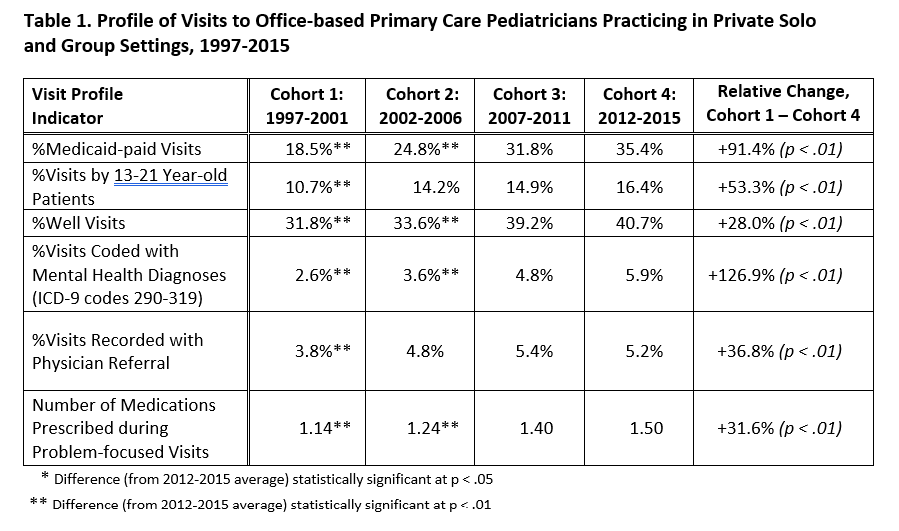Tang, Suk-fong S; Olson, Lynn; Fiks, Alexander
Background: Changes in the US health system over the past 2 decades, including but not limited to expanded public insurance coverage and decreased cost sharing for well visits may have affected pediatric primary care and impacted the day-to-day practice of pediatricians who see patients in office- settings.
Objective: Investigate potential changes in the profile of office visits provided by primary care pediatricians in private solo and group practice settings for patients through age 21 since 1997.
Design/Methods: Our analytic sample includes 50,168 (unweighted n) nationally representative non- hospital based physician office visits for patients through age 21 collected by the 1997-2015 National Ambulatory Medical Care Survey from primary care pediatricians practicing in private solo or group practice settings. We examine potential changes in the proportion of Medicaid/CHIP-paid visits, trends in patient age and well (versus problem-focused) visit mix, diagnosis of mental health conditions (ICD-9: 290-319), and prescription and referral rates across 4 cohorts (1997-2001, 2002-2006-2007-2011, and 2012-2015) using bivariate statistical analyses.
Results: We found changes in all examined indicators of visit profile over our study period (p < .01). Between 19972001 and 2012-2015, primary care pediatricians’ Medicaid/CHIP load rose from 18.5% to 35.4% (Relative change of +91%). Visits from 13-21 year-old patients increased from 11% to 16% (+53%) and well visits grew from 32% to 41% (+28%) of total visits. Mental health diagnoses grew from 2.6% to 5.9% of all visits (+127%). Prescription rate rose from 1.1 to 1.5 prescribed medications per problem- focused visit (+31.6%), and referrals were recorded for 5.8% of visits, up from 3.8% (+37%). Each indicator, measured by cohort and compared to 2012-2015, is shown in Table 1.
Conclusion(s): Our study identified changes in primary care pediatric office visit profile along multiple dimensions over the last 2 decades, most notably that pediatricians in private solo and group practices were diagnosing and treating increasingly more complex health issues as they saw more Medicaid- insured and older patients. These trends likely increase pediatricians’ work load, raise the potential for burnout and suggest a growing value for team-based care to manage complexity.

Last Updated
10/15/2021
Source
American Academy of Pediatrics